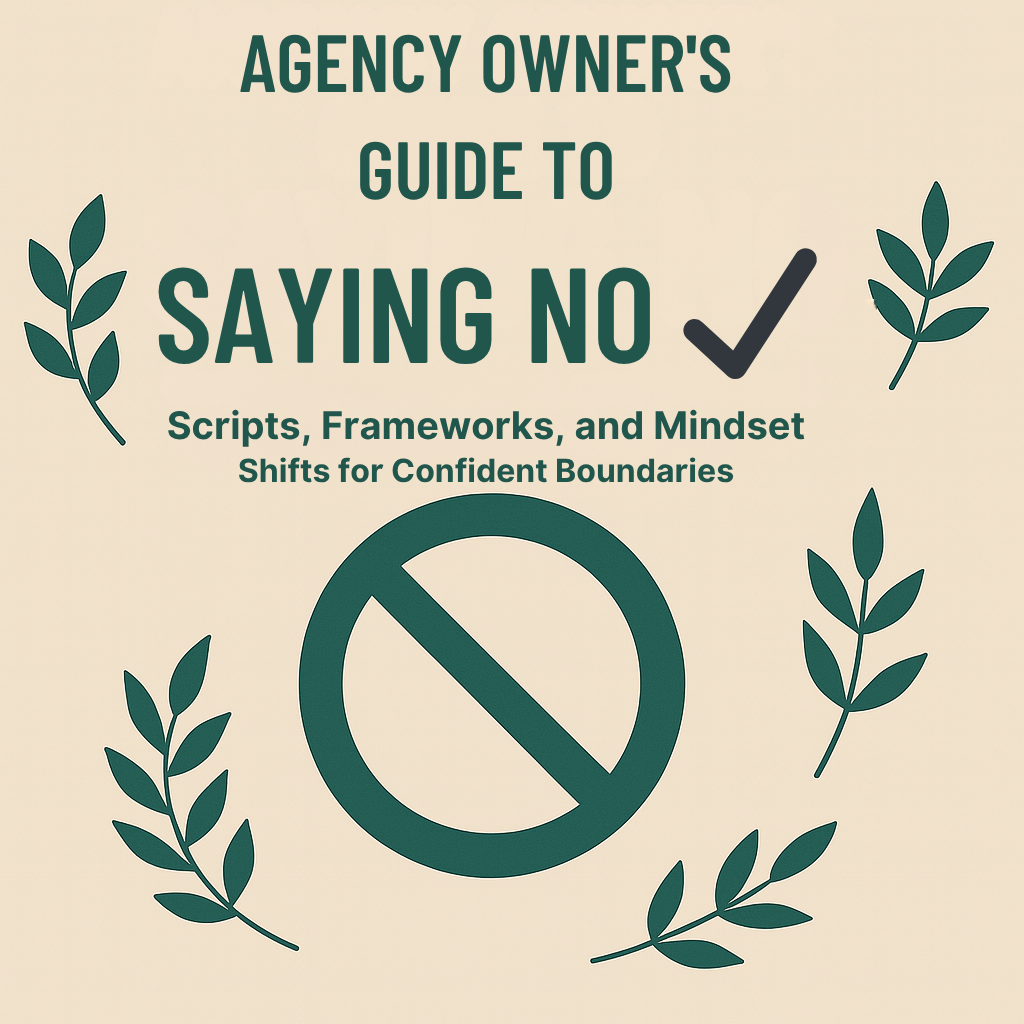"Saying no isn’t rejection—it’s direction. Every time you decline a wrong-fit client, you’re saying yes to your vision, your values, and your sanity."
TLDR
Most agency owners say yes to everything out of fear, desperation, or misguided politeness. This destroys profitability, creates operational chaos, and attracts more wrong-fit prospects. Learning to say no confidently is the fastest way to improve your agency’s performance and your own sanity.
Key Insight: Every yes to the wrong opportunity is a no to the right one. Your capacity is finite—use it wisely.
The hardest word for agency owners to say is “no.” We’re trained to be accommodating, helpful, and solution-oriented. But saying yes to everything is killing your agency.
Every wrong-fit client you accept, every scope creep request you absorb, and every discount you give weakens your positioning and attracts more of the same problems.
Here’s how to say no confidently, professionally, and strategically.
Why Agency Owners Can’t Say No
The Scarcity Mindset
“We need the money” is the most expensive phrase in agency ownership. When you operate from scarcity, you accept clients who can’t afford you, projects that don’t fit your expertise, and terms that guarantee failure.
The reality: There’s no shortage of people who genuinely need and deserve your help. Stop wasting time on those who don’t value it.
The People-Pleasing Trap
Agency owners are often natural people-pleasers who hate disappointing anyone. But trying to please everyone pleases no one—especially not your ideal clients who want to work with confident experts, not desperate vendors.
The Sunk Cost Fallacy
“We’ve already invested so much time in this prospect” keeps you chasing bad opportunities long past their expiration date. Cut your losses and redirect that energy toward better prospects.
The Strategic Framework for Saying No
The Three-Filter System
Before saying yes to any opportunity, run it through these filters:
Filter 1: Financial Fit
- Can they afford your rates without strain?
- Do they understand and accept your value proposition?
- Are they investing growth money, not survival money?
Filter 2: Operational Fit
- Do their processes align with your capabilities?
- Can you deliver excellent results with reasonable effort?
- Will this project enhance or drain your team’s energy?
Filter 3: Strategic Fit
- Does this align with your positioning and expertise?
- Will this relationship advance your business objectives?
- Would you be proud to have this in your portfolio?
If any filter fails, the answer is no.
The No Scripts That Work
For Budget-Constrained Prospects
The Situation: They love your proposal but want a 40% discount.
The Script: “I understand budget constraints are real. Unfortunately, our pricing reflects the level of expertise and results we deliver. Reducing the price would mean reducing the scope or quality, which wouldn’t serve your objectives. I’d recommend waiting until your budget aligns with the investment required for success, or I can refer you to agencies that work at different price points.”
Why It Works: Positions price as tied to value, not arbitrary. Offers alternatives without compromising your positioning.
For Scope Creep Requests
The Situation: Mid-project request for “just one small addition.”
The Script: “That’s a great idea and would definitely add value to the project. Since it’s outside our original scope, I’ll need to prepare a change order with timeline and cost implications. Would you like me to send that over, or should we discuss including it in the next phase?”
Why It Works: Acknowledges the value while maintaining boundaries. Makes the cost of scope changes explicit.
For Wrong-Fit Industries
The Situation: Prospect in an industry where you lack expertise.
The Script: “Thank you for thinking of us. While we could certainly execute this project, you’d be better served by an agency with deep expertise in [their industry]. I can recommend [specific agency] who specializes in this area and would deliver better results for your investment.”
Why It Works: Demonstrates integrity and expertise. Often leads to referrals from both the prospect and the recommended agency.
For Unrealistic Timelines
The Situation: They need a three-month project done in three weeks.
The Script: “I appreciate the urgency, and I understand the pressure you’re under. To deliver the quality results you need, this project requires [realistic timeline]. Rushing it would compromise the outcome and waste your investment. If the timeline is fixed, I can recommend approaches that might work, but they’d involve significant trade-offs.”
Why It Works: Shows you understand their pressure while maintaining professional standards. Positions you as the expert who protects their investment.
For Micromanagers
The Situation: Prospect wants daily check-ins and approval on every decision.
The Script: “I can see you’re very invested in this project’s success, which is great. Our process is designed to deliver exceptional results while respecting your time. We provide structured updates at key milestones and involve you in strategic decisions, but day-to-day execution is where our expertise adds the most value. If you prefer more hands-on involvement, you might be better served by an agency with a different working style.”
Why It Works: Reframes their micromanagement as a working style mismatch, not a character flaw. Gives them an out while protecting your process.
Advanced No Strategies
The Referral No
When you can’t take a project, refer it to a trusted partner. This builds goodwill, strengthens relationships, and often leads to reciprocal referrals.
The Script: “While this isn’t the right fit for our current focus, I know exactly who would be perfect for this project. [Agency name] specializes in [relevant area] and has delivered excellent results for similar companies. Would you like me to make an introduction?”
The Future No
For prospects who might be a good fit later but aren’t ready now.
The Script: “This sounds like a project we’d love to work on, but our timeline for new clients is [realistic timeframe]. If that works for your schedule, I’d be happy to discuss it further. If you need to move faster, I can recommend agencies with more immediate availability.”
The Partial No
When part of a project fits but part doesn’t.
The Script: “We’d be excited to handle [specific part] of this project, as it aligns perfectly with our expertise. For [other part], you’d get better results working with specialists in that area. We’re happy to collaborate with your other vendors or can recommend partners we’ve worked with successfully.”
Maintaining Relationships While Saying No
The Professional No Formula
- Acknowledge: “Thank you for thinking of us…”
- Explain: “This isn’t the right fit because…”
- Redirect: “I recommend… / You might consider…”
- Leave the door open: “Please keep us in mind for…”
Follow-Up Strategies
- Send relevant articles or resources that might help them
- Make introductions to appropriate service providers
- Connect them with potential partners or collaborators
- Invite them to industry events or educational content
Building Your “No” Network
Develop relationships with agencies that serve different markets, price points, or specializations. Regular referrals strengthen these relationships and create reciprocal opportunities.
The Mindset Shifts That Make No Easier
Abundance Over Scarcity
There are always more opportunities than you can handle. Saying no to wrong-fit prospects creates space for right-fit ones.
Expert Over Vendor
Experts have opinions, standards, and boundaries. Vendors take whatever they can get. Which do you want to be?
Quality Over Quantity
One ideal client is worth ten problematic ones. Focus your energy on relationships that energize rather than drain you.
Long-term Over Short-term
Protecting your positioning and reputation is more valuable than any single project. Think in years, not quarters.
When to Break Your Own Rules
Sometimes the strategic value of a project outweighs the immediate fit concerns:
- Learning opportunities that develop new capabilities
- Relationship investments with long-term strategic partners
- Market entry projects that establish you in new sectors
- Referral sources who consistently send ideal clients
Even then, structure these exceptions carefully with clear boundaries and exit strategies.
Your No Action Plan
- Define your filters using the three-filter system
- Practice your scripts until they feel natural
- Build your referral network of complementary agencies
- Track your nos to identify patterns
- Celebrate good nos as much as good yeses
The Bottom Line
Saying no is a competitive advantage. While your competitors chase every opportunity, you can focus on the ones that matter.
Every no to a wrong-fit prospect is a yes to:
- Higher profit margins
- Better client relationships
- Stronger team morale
- Clearer market positioning
- More referrals from ideal clients
The agencies that thrive are the ones that say no confidently and consistently. They understand that their expertise is valuable, their time is limited, and their standards are non-negotiable.
Start saying no today. Your future self will thank you.
Remember: There’s no shortage of people who genuinely need and deserve your help. Focus your limited capacity on those who value what you do.



